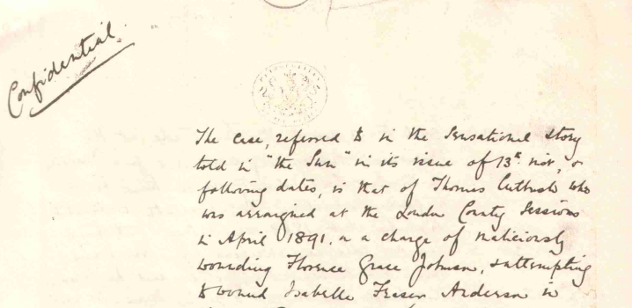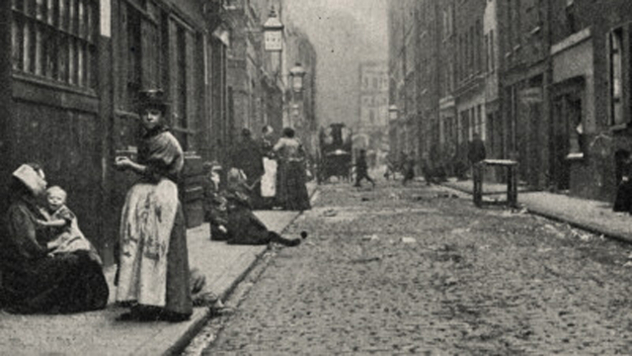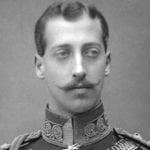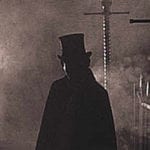SEE ALSO: Top 10 Rippers Worse Than Jack
10 Total Number Of Victims
It is generally accepted by Ripperologists (people who take a keen interest in the case) that there were five murders, known as the canonical five. However, by the time murder #1 occurred, the press already referred to this as “another” murder. Police were still considering murders in 1891 to be courtesy of Jack the Ripper. The murder of Francis Coles (pictured above) on February 13, 1891 was widely believed by the press and authorities to be his work. In all, the press attributed 11 murders to Jack the Ripper. Polly Nichols met her end on August 31, 1888, and is the first canonical murder. There is a strong case for Polly for being number two. Martha Tabrum (also known by her common-law name Turner) died August 6 at the hands of an unknown murderer. She received 39 stab wounds to her abdomen and neck, and her dress was raised, indicating either sexual intercourse or that the killer raised her dress to inflict the wounds (it was later determined there was no sexual intercourse). The similarities to the canonical five murders are apparent, most notably the attacks to the groin and upper pelvic region. Of the six non-canonical murders, Martha Tabrum has the best chance of being committed by Jack the Ripper.
9 The “Double Event” Probably Wasn’t
Of the canonical five, two murders occurred on the same night, dubbed the “Double Event” by Ripperologists. The prevailing theory is that something interrupted Jack during his first murder of the evening, driving him to a more frenzied second attack. Certainly there is little doubt that Catherine Eddowes, the second of the two women, was killed by Jack the Ripper. The murder of Liz Stride, however, the first of the Double Event, is markedly different from the other canonical five. Stride fit the age of the other victims, but everything else about the attack was quite different. Around 12:45am, Israel Schwartz witnessed a man pull a woman into the street and throw her to the ground. Schwartz ran after the attacker tossed a racial slur at him (“Lipski,” meaning Jew). Stride was dead 15 minutes later. Schwartz later identified her as the woman he saw thrown to the ground. This attack occurred 45 minutes before the murder of Catherine Eddowes. There are a number of differences between Stride and the other canonical five. Stride was likely murdered from the front; she was facing her killer. The three prior (counting Tabram) were struck from behind. The location seems quite different. Jack preferred very quiet, secluded places, yet Schwartz saw the attack first occur in the middle of the road. Her wounds were caused by a different knife to the one used to kill Eddowes 45 minutes later. Famous modern-day profiler John Douglas believes this is not significant, as of course Jack would have more than one knife. Douglas strongly supports the Double Event theory. He reasons that that two unrelated murders occurring in such close proximity on the same evening would be too much of a coincidence, and therefore that they were both committed by the same hand. So does John Douglas think that John Brown is Jack the Ripper? Who is John Brown? Brown murdered his wife Sarah on the evening of September 29, 1888. His deed occurred two hours and three miles from the Double Event. Yet you’ll never hear Brown mentioned as a suspect. And rightfully not—just because he committed a murder on the same evening as two others doesn’t mean he committed all three. Location isn’t always a factor in murders. The only thing linking the Double Event is proximity.
8 Authenticity Of The Jack The Ripper Letters
The media and police received over 700 pieces of correspondence claiming to be from “Jack.” Two are considered credible by Ripperologists. The first letter to gain notoriety was the infamous “Dear Boss” letter addressed to the Central News Agency. The affixed signature “Jack the Ripper” gained notoriety when a threat in the letter to “clip the (next victims) ears off” was carried out with the murder of Catherine Eddowes. The true author of the letter remains a mystery. Three prominent police officers stated that a newspaper man wrote the letter. A personal letter by John Littlechild, head of the Special Branch of the London Metropolitan Police, went further and actually named the newspaper man who wrote it: “Bullen” (real name Thomas Bulling). There is debate over whether the police truly knew the origin of the “Dear Boss” letter, but in 1888, the police thought it was a hoax. George Lusk, President of the Whitechapel Vigilance Committee, received another noteworthy letter, claiming to be “From hell.” Included in the crudely written letter was half a kidney, which the author claimed came from a victim (Catherine Eddowes). A doctor stated that the kidney belonged to a woman, roughly 45 years of age, and suffering from alcoholism (in other words, Eddowes). However, that would have been virtually impossible to medically conclude at that time. It’s interesting that the letter went to someone hunting after the murderer, rather than someone covering the case, however Lusk considered the letter to be a hoax. It remains possible that none of the Jack the Ripper correspondence was by the real killer.
7 The Macnaghten Memorandum
One key document for Ripperologists is an 1891 letter from Sir Melville Macnaghten (Assistant Crime Commissioner) to The Sun newspaper regarding the arrest of a Thomas Cutbush, for the crime of stabbing several women in the buttocks, and The Sun’s accusation that Cutbush was Jack the Ripper. Macnaghten pointed out that Cutbush had never killed anyone, and listed three suspects who were better candidates for Jack: “(1) A Mr M. J. Druitt, said to be a doctor & of good family — who disappeared at the time of the Miller’s Court murder, & whose body (which was said to have been upwards of a month in the water) was found in the Thames on 31st December — or about 7 weeks after that murder. He was sexually insane and from private information I have little doubt but that his own family believed him to have been the murderer. (2) Kosminski — a Polish Jew — & resident in Whitechapel. This man became insane owing to many years indulgence in solitary vices. He had a great hatred of women, specially of the prostitute class, & had strong homicidal tendencies: he was removed to a lunatic asylum about March 1889. There were many circumstances connected with this man which made him a strong ‘suspect’. (3) Michael Ostrog, a Russian doctor, and a convict, who was subsequently detained in a lunatic asylum as a homicidal maniac. This man’s antecedents were of the worst possible type, and his whereabouts at the time of the murders could never be ascertained.” It’s possible that Macnaghten intended the letter only to demonstrate how unlikely a suspect Cutbush was, not to identify any of the three men as legitimate “main suspects,” but rigorous Ripperologists cannot afford to make that assumption. The fact that the murders stopped soon after Druitt’s suicide is suspicious, but payslips found in his pockets indicate that his death was unrelated. It seems that he was fired from his teaching position days before his suicide, likely as a result of a homosexual scandal—that is the terrible trait that “sexually insane” refers to. The third candidate, Michael Ostrog, was a con artist and petty thief. He had no ties to any of the victims or the crime scenes, and the crimes he did commit had grown less intense over his career, not more, and although he had had occasional violent outbursts, they were never planned or methodical. He is not considered a serious suspect. That leaves Kosminski. Although modern minds will find it hard to condemn a man on the basis of his “solitary vices” (masturbation), there are more legitimate indicators. Aspects of his childhood (witness to sexual brutality, absent father) fit the classic serial killer profile. Several witnesses said the killer looked Jewish, although his is suspect as anti-Semitism was rife at the time. The one witness who specifically identified Kosminski was Jewish himself, however, although he refused to officially testify. And Kosminski was interred in a lunatic asylum not long before the murders ceased. One theory goes that the police knew Kosminski was the Ripper, but had him sent to the asylum rather than arrested, because they did not have the evidence to convict him. But if that was the case, why have no internal documents turned up to corroborate it? Nevertheless, Kosminski must be considered a highly plausible candidate.
6 The Killer Wasn’t Left-Handed
Jack the Ripper might be the most famous southpaw killer, along with Billy the Kid. But of course you know from your Listverse knowledge that Billy was right-handed. Jack the Ripper probably was too. The principle identification of Jack the Ripper as a lefty comes from Dr. Rees Ralph Llewellyn. He carried out the post mortem on Polly Nichols, the first victim (or maybe second, depending on how you feel about this list). The specific passage is: “…her throat had been cut from left to right, two distinct cuts being on the left side, the windpipe, gullet and spinal chord being cut through; a bruise apparently of a thumb being on the right lower jaw, also one on the left cheek, the abdomen had been cut open from centre of bottom of ribs along right side, under pelvis to left of stomach, there the wound was jagged; the omentum, or coating of the stomach, was also cut in several places, and two small stabs on private parts; apparently done with a strong bladed knife; supposed to have been done by some left handed person; death being almost instantaneous.” Dr. Llewellyn’s claim that the killer was left-handed was based on neck bruising and the direction of the cuts (left to right—it was thought at the time that Jack slit his victims throats from behind), but how closely were those observations made? According to the Times and The Telegraph (September 1, 1888) accounts state that the doctor “will make no actual post mortem until he receives the coroner’s orders.” In other words, Dr. Llewellyn decided the killer was left-handed prior to carrying out the autopsy! Lefties at that time were viewed with suspicion at best, and were often associated with the Devil. Early criminologist Cesare Lombroso claimed that left-handed people were three times more likely to commit a crime than their right-handed brethren. Further studies of the crime scene demonstrated that Jack had strangled his victims front on, then lain them on the ground to mutilate them. This contradicted Llewellyn’s theory, and the doctor himself later retracted it, but the so-called “sinistral theory” had already caught hold in the public imagination, and anti-lefty prejudice made it hard to budge.
5 He Had An MO
Jack the Ripper didn’t just kill at random. Like modern serial killers, he had a “type.” Four of the five canonical victims were approximately the same age—late 30s to 40s. His highly specific method of killing is stated in the last entry. He struck on weekends or bank holidays (including Martha Tabrum). And obviously the reason he’s so well remembered—besides never being caught—is the graphic nature of the wounds. If you throw out the Stride murder (either because she wasn’t killed by Jack or because he was interrupted during her murder), they all had some pelvic mutilation. Catherine Eddowes and Liz Stride were the only murders to occur in what would be considered “late at night”—1am or so. The others occurred between 3am and 6am. That might seem late in modern times, but in the 1880s, that was just a bit before morning rush-hour. People on their way to work found canonical victim #1 Polly Nichols at 3:40am. That would indicate Jack had employment. The murders (apart from Stride’s) were in secluded places. Jack had a pretty good knowledge of Whitechapel. Catherine Eddowes was murdered between walking shifts of patrol officers, which indicates that he was either very lucky or paid attention to where police (and other people) would be in planning his crimes.
4 Not The Doctor
One of the more well-known theories pins the Whitechapel murders on Dr. William Withey Gull, Queen Victoria’s own doctor. It’s the story portrayed in the movie From Hell, based on the graphic novel by Alan Moore, itself based on Steven Knight’s book The Final Solution. The movie is actually pretty good, the graphic novel even better, and both are completely and hopelessly wrong when it comes to the case. According to Knight’s theory, the murders were part of a Masonic conspiracy that included a royal scandal, ritualistic murder, and a giant cover-up. Gull was first fingered as a suspect by several American newspapers in the 1890s, who had strong political motivations for maligning the British aristocracy. Gull’s advocacy for women’s involvement in medicine also made him a suspicious figure. Born in 1816, Dr. Gull would have been 71 at the time of the Jack the Ripper murders (witnesses put the murderer in his 30s). He had a stroke 11 months before the murder of Polly Nichols, putting him in incredibly poor health. Further, the conspiracy relies on certain high-ranking individuals being Freemasons, when Masonic records show they definitely were not. Dr. Gull was most assuredly not Jack the Ripper. The mutilations perpetrated on the victims involved careful removal of the uterus, kidneys, and other organs, and this fact has led many people to believe Jack the Ripper must have been a doctor. However, knowledge of anatomy could be gained by the layman by viewing public dissections of criminals, and there were other professions with anatomical knowledge as well—historian William Stewart claimed in 1939 that the killer might have been a woman, a “mad midwife” or abortionist.
3 The Best-Known Suspects Are Ridiculous
Want to know who Jack the Ripper wasn’t? Prince Albert Victor. As grandson of Queen Victoria, his name comes up often as part of a vast conspiracy of sadism and privilege, reaching all the way to the crown itself. The allegation that a prince was killing paupers was first claimed in a 1962 book but IT probably started a bit earlier. While it makes a good story, it’s simply not possible: The Prince was nowhere near London when the murders occurred. London had a population of around four million at that time, meaning there were thousands of people with no alibi who could, in theory, be the Ripper. So it’s suspicious that so many writers are convinced it had to be a celebrity, and in particular accuse those who it would be especially shocking if they turned out to be murderers, like members of the royal family, or children’s book authors. Richard Wallace claimed in a 1996 book that Lewis Carroll not only killed prostitutes in the East End, but hid clues to it throughout Alice in Wonderland. Those “clues” involve rearranging the letters of random passages from the book into brutal descriptions of prostitute murder. The problem is that you could do that with almost any book at all—especially if you were willing to switch out letters that didn’t fit, as Wallace did. That is literally his only piece of evidence against Carroll, and even that doesn’t hold up, since Carroll was such a clever and creative wordsmith that if he wanted to insert playful murder-clues into his books, he could have come up with something a lot better than the ones Wallace suggests. Carroll was just one of the many, many men in the same city at the same time as the murders happened. Keep that in mind you hear any other famous name associated with the Whitechapel murders, such as Winston Churchill’s father (also alleged to be part of a Masonic conspiracy) or the Elephant Man.
2 There Were Eyewitnesses And Clues
The common notion that Jack the Ripper killed silently and departed without a trace is a myth. Specifically, he left clues to his identity and location when he killed Catherine Eddowes. Joseph Lawende was walking along with two others around 1:35am on the night of her murder. He saw a man with a woman he identified as Eddowes (from her clothing), and later described him to The Times as “of shabby appearance, about 30 years of age and 5ft. 9in. in height, of fair complexion, having a small fair moustache, and wearing a red neckerchief and a cap with a peak.” Eddowes was dead 10 minutes after she was spotted with the man. Witnesses to the other murders confirm most details of this description, although usually have him wearing more genteel clothing. Almost 90 minutes after Eddowes’ murder, Police Constable Alfred Long discovered a bloody piece of her apron, very close to some graffiti. It read: “The Juwes are the men that will not be blamed for nothing.” It was quickly removed by police for fear it would incite a riot. It is much debated whether Jack the Ripper was an anti-Semite, or whether he was Jewish and wrote it to point the police in the wrong direction, or if someone else wrote it to capitalise on the murder. The more useful clue is the location of the apron. Eddowes’ murder occurred southwest of Whitechapel. Technically, it was in London, not Whitechapel. Jack the Ripper traveled back toward the heart of Whitechapel. Jack the Ripper resided in Whitechapel (pictured above), not London proper.
1 Modern Research Might Solve This Case
Amateur sleuths have advanced the Jack the Ripper case to the point where it seems plausible that the case will be solved. Yes, really. Many records were destroyed during the London Blitz, but others were only lost and are still being rediscovered. For example, in 1993, a letter by the aforementioned John Littlechild was discovered, revealing an entirely new suspect: Francis Tumblety. Tumblety was a quack American doctor in Whitechapel at the time of the murders, and to learn that he was considered as a suspect by police is explosive information for Ripperologists. Further research turned up a report by a contemporary of Tumblety, Colonel Dunham, who said the doctor had jars and jars of uterus specimens, and that, when asked why no women had been invited to dinner, “his face turned as black as a thunder-cloud,” he replied “No, Colonel, I don’t know any such cattle, and if I did I would, as your friend, sooner give you a dose of quick poison than take you into such danger” and that he then “fiercely denounced all women and especially fallen women.” Historical census data is now available online, and is easily cross-referencable in a way that simply wasn’t possible in 1888. This has brought to light facts that, had they been available at the time, would have interested Scotland Yard very much indeed. Charles Cross was the first person to find the body of canonical victim #1, Polly Nichols. In fact, he was found with the victim, by a second witness. Cross lived within a few minutes of the crime scene, but as this was the first murder, no one found this particularly suspicious. They should have. Modern researchers have since established that two of the other canonical victims were killed on the route between his home and work. Polly Nichols was not as badly mutilated as some of the later victims, and while serial killers often do escalate in intensity, it could also have suggested that the killer was interrupted—making Cross an even more likely suspect. As of now we don’t have the information to determine whether either of those individuals was Jack the Ripper, but it was modern research by amateur sleuths that discovered inconsistencies in their testimonies, and that of some other suspicious “witnesses.” Many important documents and clues were seized as souvenirs, at the time of the murders and later by Ripperologists. When these documents come to light over the coming years, we may finally be able to solve the biggest murder mystery of the last 200 years. Jake wrote a trivia e-book filled with crazy stuff like the kind you just read in this list. You can follow him on twitter for more useless facts.
























